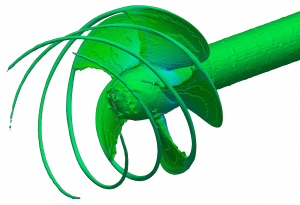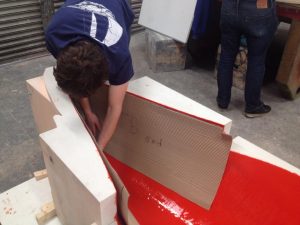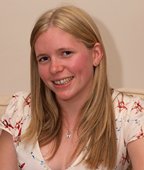Today’s seminar from Professor Paul Weaver will take place in B27 room 2003 from 14:00-15:00.
Abstract
A structure should resist loads without failing. For structures that contain humans, i.e. houses, boats, cars, aeroplanes etc., they do not stretch (or deform) a great deal (thankfully!) and those that are required to move around should be lightweight to keep fuel costs down e.g. aeroplanes and superlightweight to overcome gravity (e.g. rockets, spacecraft). This seminar explores the possibility of using unusual properties of materials with some additional nonlinear geometric behaviour to either reduce mass or to achieve a significant shape change (morphing) of a structure. Examples are drawn from bicycles, aeroplanes, helicopters, rockets, wind turbine blades, my Ferrari (I wish!) and Nature.
Biography
Paul Weaver is a Chair in Lightweight Structures at the University of Bristol and and until recently was its Engineering Faculty Research Director. He also directs the ACCIS Centre for Doctoral Training. He has published in excess of 200 refereed papers, had 5 patents and graduated 25 PhD students. He has worked on composite structures since 1987, firstly at Newcastle University and what was then Courtauld’s Aerospace on his PhD, before joining Prof Mike Ashby and his group as a postdoc at Cambridge University. Paul then joined Bristol University in 1998, becoming an EPSRC Advanced Research Fellow from 2002-2007 and then gaining his Chair in 2009. During this time Paul was a regular visitor and consultant to NASA Langley on buckling and postbuckling design methods of plate and shell structures. He has worked with Airbus on various projects since 1999 and has delivered methods for coupled stress/temperature modelling for what was then the A3XX, buckling solutions for anisotropic plates, optimisation methods for composite plates, design for stringer plate terminations and most recently on spatially variable stiffness composite plates under the ABBSTRACT project. His anisotropic blade concept for the BERP IV blade is flying on EH101 helicopters. More broadly, his work on morphing composites is being considered for use in wind turbine designs, F1 and high performance boats.
Category Archives: Uncategorized
Foiling experts…
A group of FSI members helped CNN’s Mainsail programme presenter Shirley Robertson (double GB Sailing Gold medal winner) present a piece on the physics of foiling craft using Southampton Solent’s towing tank. The episode can be found via the on-line link below. There are three parts with our contribution featured in the second. There are some really nice shots of our new building and Gabe Weymouth and Joe Banks provide convincing commentaries. As with all TV there was a significant amount of background preparation (and hanging around) to get the right shots! Many thanks to all concerned and especially James Blake who helped pull it all together following an initial discussion after Shirley’s inspiring lecture last year as part of our University of Southampton – RNLI joint Technology Partnership programme.
http://edition.cnn.com/videos/tv/2015/03/11/spc-mainsail-design-special-b.cnn/video/playlists/intl-mainsail/
Engines and Data March 12th 14:00-15:00 B175/1025
Professor Richard Stobart, Technical Director Caterpillar Innovation & Research Centre at Loughborough University will deliver an invited seminar on
“Engines and Data: How strategies for data can change the design, development and operation of an established concept”.
Abstract
The heat engine is a very long established concept – and for most of its existence the solutions to efficient and reliable operation lay in the domain of mechanical engineering. Recently, increasing pressure on air quality and fuel efficiency, has led to the introduction of electronic management schemes for engines that replaced complex mechanical components. Electronic schemes were able to offer automation of data collection and enable diagnosis and prognosis, particularly in equipment where an engine failure posed a safety risk or would result in significant financial loss.
Data taken from the fundamental processes of the engine has always been important in understanding and diagnosing development issues and during operation, incipient faults. Sensing methods are allowing even those high speed data streams to be analysed and their features incorporated into schemes that include other observations from the engine. Today’s very substantial flows of data from the engine offer potential to accelerate the development process and to begin to change the nature of engine components and their operation.
This presentation will briefly reflect on the history of the heat engine and the early uses of data, before reviewing the current use of data in control and diagnosis. We will consider new techniques that are emerging from current research and assess their potential impact on not just heat engines but the wider use of capital intensive equipment.
Biography
Richard Stobart is Professor of Powertrain Systems at Loughborough University. Loughborough was the UK’s first technological University and is ranked as world class in Mechanical, Aeronautical and Manufacturing Engineering.
He is responsible for the development of research and education in the field of vehicle engineering, with a particular focus on propulsion and power generation systems.
He was Professor of Automotive Engineering at the University of Sussex (Brighton, UK) from 2001 to 2007 where he was also Head of Engineering and Design from 2003 to 2006.
Professor Stobart was a member of the team who, in 1997 received Arthur D Little’s Ketteringham prize for their work in developing fuel cell technology. The prize was offered annually for the most significant contribution to the company’s products and capabilities. He is a graduate of the University of Cambridge with a first class honours degree in Mechanical Engineering. He was elected a Fellow of the UK Institution of Mechanical Engineers in 2000 and Fellow of the Society of Automotive Engineers in 2015.
Latest OpenFoam Group meeting

We held our semi-regular meeting for people using the open-source Computational Fluid Dynamics (CFD) tool, OpenFOAM (http://www.openfoam.com/). The meeting saw an attendance of over 15 postgraduate students, staff and alumni from research groups across the University, Lloyd’s Register and industry.
Hydrofoil_cavitation_video
We had an opportunity to get to know people dealing with similar problems, expand our knowledge of applicability of OpenFOAM to different engineering problems, and have a refreshing break from chewing through the log files of our simulations. The next meeting is planned at the end of the summer term so keep your eyes open for the announcement around mid-June.
Success at SET for Britain award
 I wish to extend our hearty congratulations to one our of PhD students Agnieszka who was awarded a Bronze medal in the final event of the SET for Britain Engineering category held at the Houses of Parliament. ‘The SET for Britain award exists to “present and discuss “ground-breaking” and frontier UK research and R&D to members of both Houses of Parliament at Westminster”.
I wish to extend our hearty congratulations to one our of PhD students Agnieszka who was awarded a Bronze medal in the final event of the SET for Britain Engineering category held at the Houses of Parliament. ‘The SET for Britain award exists to “present and discuss “ground-breaking” and frontier UK research and R&D to members of both Houses of Parliament at Westminster”.
Dr James Blake her PhD Supervisor commented that Agnieszka’s research centres on the through life degradation mechanisms for natural composites for structural marine applications, supported by LR. Her research transcends the levels of quantum chemistry to structural component level and looks at re-engineering natural resin systems for optimum performance. Agnieszka is co-supervised by Dr Alan Chambers and by Dr Robert Raja with whom we have the good fortune of working closely with in Chemistry through our SMMI links.
engineering@outhampton did well overall picking up the silver and bronze awards in the Engineering category.
Risk in Practice SMMI-LR Seminar 26th Feb 12:30-13:30 175/1025
Please come along to catch up on the latest thinking on risk.
Access to B175/1025 is via reception of B176. All are welcome
Vince Jenkins from LR will present on the following
Risk Management and Risk Assessment is a term that is everywhere today, how did we ever manage without it?
Is the term so often used or misused that it is of little value?
A different approach to the assurance of engineering design safety started in the UK nuclear industry in the late
1950’s. This presentation will revisit the fundamental objectives of the approach, and seek to answer several questions:
• Are the objectives of risk management still appropriate today?
• What degree of risk management is required in ship design?
• What the professional engineer needs today.
Behind the Cameras at the 34th America's Cup
For those interested there will be a Southern Joint Branch RINA/IMarEST meeting on the 4th March at 14:00 for 14:30 by Alasdair Green, of ACLiveLine. Registration is advised more info on file attached AmericasCup (3)
Lecture Theatre A, Physics Building (Building No. 46), Highfield Campus, Southampton, SO17 1BJ
Ship Science Group Design Projects
 Our finalists are hard at work on their group design projects. These projects, worth a third of their marks in the final year are the culmination of the MEng degree programmes. This year the results of all the projects will be on display in our Faculty’s first end of year design show on the 12th June. If you would like an invite please contact us for further details. As the projects start coming to completion we will be posting information at to their achievements.
Our finalists are hard at work on their group design projects. These projects, worth a third of their marks in the final year are the culmination of the MEng degree programmes. This year the results of all the projects will be on display in our Faculty’s first end of year design show on the 12th June. If you would like an invite please contact us for further details. As the projects start coming to completion we will be posting information at to their achievements.
One GDP project this year – Team Fortitude are building an autonomous surface vessel with the capability of crossing the Atlantic. Such vessels will become ever more common and provide some exciting applied naval architecture and marine engineering challenges as well as enhancing our Maritime Robotics interests as we look into the challenge of increased use of autonomous systems in Maritime Shipping.
On-going research into the impact of freak waves on ships
Freak (or abnormal or rogue or extreme) waves are a now well-known phenomenon due to widely publicised reports in the media of ship encounters with such waves.
 Research at the University of Southampton has been being conducted into the influence of freak waves on ships since 2007. Led by Dr Sally Bennett, investigations have taken the form of extensive towing tank testing into the motions and global loads experienced by a travelling vessel when encountering a freak wave in a range of sea conditions representative of those found around the globe. Such waves are unexpected, with a height at least twice that of the surrounding sea state. Often they occur in regular shipping lanes, meaning they are a real problem for the worlds shipping.
Research at the University of Southampton has been being conducted into the influence of freak waves on ships since 2007. Led by Dr Sally Bennett, investigations have taken the form of extensive towing tank testing into the motions and global loads experienced by a travelling vessel when encountering a freak wave in a range of sea conditions representative of those found around the globe. Such waves are unexpected, with a height at least twice that of the surrounding sea state. Often they occur in regular shipping lanes, meaning they are a real problem for the worlds shipping.

Results have shown significant increases during tank testing not only in the measured responses but also those observed using high-speed camera imagery, compared to in a random sea state that does not contain a rogue wave. Figure 1 shows a naval frigate travelling at the model scale equivalent of 18 knots through a freak wave; rather than being able to climb over the wave the vessel instead tunnels though the wave crest before falling down into the following wave trough resulting in significant amounts of green water and slamming loads on the bow of the vessel. Indeed measurements showed that the accelerations as well as the loads experienced by the vessel were substantially larger in this scenario than in a comparable random sea. Continue reading On-going research into the impact of freak waves on ships
Predicting the performance of uncertain systems with application to vibro-acoustics and electromagnetics
Prof Robin Langley will be speaking this Thursday 12th at 2pm in room 2013 in building 176. All welcome.
This talk will review computational methods for the analysis of built-up systems that have very many degrees of freedom, and which have uncertain or random properties. The aim is to predict not only the nominal performance of the system, but also the statistical distribution of the performance over an ensemble of random systems. A key element of the talk will be Statistical Energy Analysis (SEA), a technique that was championed at Southampton for many years by researchers such as Fahy, Lalor, Pinnington, Keane, Price, and Mace. Various extensions to this approach will be discussed including: the inclusion of non-parametric statistics and variance prediction, the coupling of SEA to the finite element method, the analysis of the combined effect of parametric and non-parametric uncertainty, and the prediction of performance limits.
Various industrial examples will illustrate the application of the method to aeronautical and automotive systems, and to electromagnetic compatibility (where the concern is with electromagnetic waves and Maxwell’s equations).
Biography
Robin Langley is Professor of Mechanical Engineering and Head of the Division of Mechanics, Materials and Design, in the Cambridge University Engineering Department. He has previously held academic positions at Cranfield and Southampton (Department of Aeronautics and Astronautics, 1991-1998), and he acts as a consultant to industry: previously with ESI on the development of the software package VA One, and most recently with Wavesix LLC on vibro-acoustics and electromagnetics.
